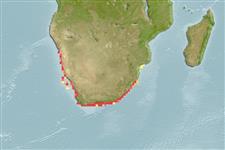Teleostei (teleosts) >
Eupercaria/misc (Various families in series Eupercaria) >
Sparidae (Porgies)
Etymology: Chrysoblephus: Greek, chrysos = golden + Greek, blepo, blepharizo = to watch (Ref. 45335).
More on author: Valenciennes.
Environment: milieu / climate zone / depth range / distribution range
Ecology
Marine; demersal; non-migratory; depth range 30 - 100 m. Subtropical; 22°S - 35°S
Western Indian Ocean: known only from South Africa.
Length at first maturity / Size / Weight / Age
Maturity: Lm 36.5 range ? - 42 cm
Max length : 75.0 cm TL male/unsexed; (Ref. 3198); common length : 40.0 cm TL male/unsexed; (Ref. 3507); max. published weight: 7.3 kg (Ref. 40637)
Found over rocky banks (Ref. 3198). Feeds on crustaceans, mollusks, worms, and small fishes. Seldom caught from the shore (Ref. 3198). Sold fresh in markets.
Life cycle and mating behavior
Maturity | Reproduction | Spawning | Eggs | Fecundity | Larvae
Also Ref. 28504.
Bauchot, M.-L. and M.M. Smith, 1984. Sparidae. In W. Fischer and G. Bianchi (eds.) FAO species identification sheets for fishery purposes. Western Indian Ocean (Fishing Area 51). volume 4. [var. pag.] FAO, Rome. (Ref. 3507)
IUCN Red List Status (Ref. 130435: Version 2024-1)
Threat to humans
Harmless
Human uses
Fisheries: commercial; gamefish: yes
Tools
Special reports
Download XML
Internet sources
Estimates based on models
Preferred temperature (Ref.
123201): 13.7 - 23.8, mean 17.5 °C (based on 12 cells).
Phylogenetic diversity index (Ref.
82804): PD
50 = 0.5156 [Uniqueness, from 0.5 = low to 2.0 = high].
Bayesian length-weight: a=0.01738 (0.01072 - 0.02817), b=2.99 (2.85 - 3.13), in cm total length, based on LWR estimates for this species & Genus-body shape (Ref.
93245).
Trophic level (Ref.
69278): 3.7 ±0.54 se; based on food items.
Resilience (Ref.
120179): Low, minimum population doubling time 4.5 - 14 years (K=0.07).
Fishing Vulnerability (Ref.
59153): High to very high vulnerability (68 of 100).
Nutrients (Ref.
124155): Calcium = 51.1 [22.8, 91.4] mg/100g; Iron = 0.828 [0.442, 1.800] mg/100g; Protein = 19.1 [17.9, 20.3] %; Omega3 = 0.257 [0.144, 0.443] g/100g; Selenium = 31 [13, 73] μg/100g; VitaminA = 8.36 [1.75, 33.19] μg/100g; Zinc = 0.629 [0.411, 0.939] mg/100g (wet weight);
